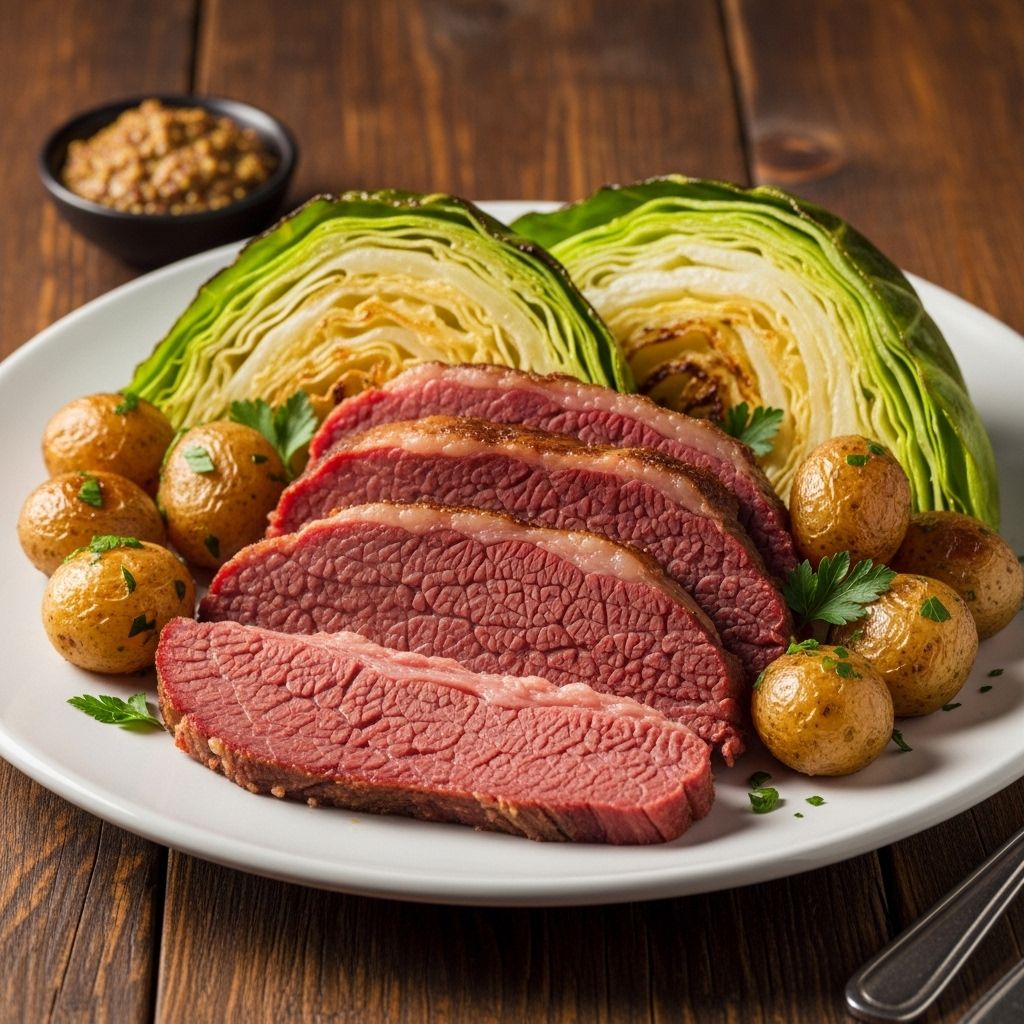Corned Beef And Cabbage Recipe: Easy Step-By-Step Guide
Discover the secrets to preparing the perfect corned beef and cabbage for your St. Patrick's Day celebration

Image: HearthJunction Design Team
Classic Corned Beef and Cabbage: The Ultimate St. Patrick’s Day Tradition
Corned beef and cabbage stands as the quintessential Irish-American meal, particularly beloved during St. Patrick’s Day celebrations. This hearty, flavorful dish combines tender, slow-cooked corned beef brisket with fresh cabbage, potatoes, and carrots for a complete meal that satisfies both tradition and taste buds. While many associate this dish exclusively with March festivities, its comforting nature and rich flavors make it a wonderful choice year-round when you’re craving something substantial and nourishing.
The beauty of corned beef and cabbage lies in its simplicity. Despite its impressive presentation and complex flavors, the cooking process requires minimal hands-on time, allowing the slow simmering to work its magic while you attend to other matters. The result is fork-tender meat with perfectly cooked vegetables, all infused with aromatic spices traditionally included in the corned beef preparation.
What is Corned Beef?
Before diving into the recipe, let’s understand what makes corned beef special. Despite its name, there’s no corn involved in corned beef. The term “corned” refers to the large grains of salt (called “corns”) historically used to cure the meat. Modern corned beef is typically made from beef brisket that has been cured in a seasoned brine solution. The curing process traditionally includes salt, sugar, and various spices like peppercorns, bay leaves, mustard seeds, and coriander.
When you purchase corned beef for this recipe, it typically comes pre-brined and packaged with a small spice packet that contains the perfect blend of seasonings to complement the meat during cooking. This convenient preparation makes creating an authentic-tasting dish accessible to home cooks of all experience levels.
Ingredients for Perfect Corned Beef and Cabbage
To prepare this classic dish, you’ll need the following ingredients:
- 4 pounds corned beef brisket with spice packet
- 1 large head cabbage (approximately 2 pounds)
- 8 medium potatoes (preferably red or yellow varieties)
- 6-8 carrots
- Water (enough to cover the brisket in your Dutch oven or large pot)
The simplicity of these ingredients highlights the rustic, traditional nature of this dish. Each component plays an essential role: the corned beef provides rich, savory flavor; the cabbage offers slight sweetness and pleasant texture; the potatoes add heartiness and substance; and the carrots contribute natural sweetness and vibrant color.
Essential Equipment
To successfully prepare corned beef and cabbage, you’ll need a few key pieces of kitchen equipment:
- Large Dutch oven or heavy-bottomed pot with lid (6-8 quart capacity)
- Sharp chef’s knife for cutting vegetables
- Cutting board
- Slotted spoon for removing vegetables
- Meat thermometer (optional but helpful)
- Carving knife for slicing the finished brisket
The Dutch oven is particularly important as it provides even heat distribution and excellent heat retention, which are crucial for the long, slow cooking process that transforms the corned beef from tough to tender.
Step-by-Step Cooking Instructions
Preparing and Cooking the Corned Beef
The first stage of this recipe focuses on properly cooking the corned beef brisket:
- Remove the corned beef brisket from its packaging, reserving the spice packet. Rinse the meat thoroughly under cold water to remove excess salt from the brining process.
- Place the brisket in a large Dutch oven or pot, fat side up.
- Add enough cold water to cover the meat completely.
- Sprinkle the contents of the spice packet over the meat and water.
- Bring the water to a boil over high heat.
- Once boiling, reduce the heat to a gentle simmer, cover the pot, and cook for approximately 2 hours. During this time, the meat will begin to tenderize and absorb the flavors from the spices.
- Occasionally skim any foam that rises to the surface of the liquid.
Preparing the Vegetables
While the corned beef is simmering, prepare your vegetables:
- Wash all vegetables thoroughly.
- Cut the potatoes in half. If using larger potatoes, quarter them to ensure even cooking.
- Peel the carrots and cut them into 2-inch chunks.
- Remove any damaged outer leaves from the cabbage, then cut it into 8 wedges, keeping the core intact on each wedge to help them hold together during cooking.
Adding the Vegetables
After the corned beef has simmered for approximately 2 hours and is beginning to tenderize:
- Add the halved potatoes and carrot chunks to the Dutch oven, nestling them around the brisket.
- Continue to simmer for about 10 minutes, until the vegetables begin to soften but aren’t completely tender.
- Gently place the cabbage wedges on top of and around the meat and other vegetables.
- Cover and continue to cook for approximately 15 more minutes, until the cabbage is tender and the potatoes can be easily pierced with a fork.
Finishing the Dish
- Once everything is cooked to perfection, carefully remove the corned beef from the Dutch oven and transfer it to a cutting board.
- Allow the meat to rest for approximately 15 minutes. This resting period is crucial as it allows the juices to redistribute throughout the meat, ensuring a moist, flavorful result.
- While the meat rests, keep the vegetables and broth warm in the Dutch oven.
- After resting, slice the corned beef across the grain into 1/4-inch thick slices. Cutting against the grain is essential for tender meat, as it shortens the muscle fibers.
Serving Suggestions
To serve this classic dish in traditional style:
- Arrange several slices of the corned beef on each plate.
- Add a selection of the vegetables alongside the meat.
- Ladle some of the flavorful cooking broth over the meat and vegetables.
- Serve with Irish soda bread or crusty bread for soaking up the delicious broth.
- Traditional accompaniments include mustard (particularly whole grain mustard) and horseradish sauce for the corned beef.
For a complete Irish-themed meal, consider serving with a pint of Guinness or another Irish stout beer, which complements the flavors beautifully.
Storage and Leftover Ideas
Proper Storage
If you find yourself with leftovers, proper storage will ensure they remain delicious for future meals:
- Allow all components to cool completely before refrigerating.
- Store the corned beef, vegetables, and broth in separate airtight containers in the refrigerator.
- Properly stored leftovers will remain good for up to three days in the refrigerator.
- When reheating, ensure the meat reaches an internal temperature of 165°F (74°C) for food safety.
Freezing Options
Corned beef and cabbage can be frozen for longer storage:
- Cool all components completely.
- Divide into portion-sized containers or freezer bags.
- Label with the date and contents.
- Wrap each container in aluminum foil for added protection against freezer burn.
- Freeze for up to 2-3 months.
- Thaw overnight in the refrigerator before reheating.
Creative Leftover Ideas
Leftover corned beef can be transformed into several delicious dishes:
- Corned Beef Hash: Chop leftover corned beef and potatoes, fry with onions, and top with a fried egg for a hearty breakfast.
- Reuben Sandwiches: Layer sliced corned beef with Swiss cheese, sauerkraut, and Russian dressing on rye bread, then grill until golden.
- Corned Beef Tacos: Shred the beef and serve in warm tortillas with cabbage slaw and spicy sauce.
- Corned Beef Soup: Add chopped corned beef to vegetable soup for extra flavor and protein.
Tips for Perfect Corned Beef and Cabbage
- Don’t skip rinsing: Rinsing the corned beef before cooking helps remove excess salt from the brining solution, preventing your final dish from being too salty.
- Low and slow: Keep the heat at a gentle simmer throughout the cooking process. Boiling can make the meat tough.
- Timing matters: Adding the vegetables in stages ensures everything is perfectly cooked. Cabbage cooks quickly and can become mushy if added too early.
- Let it rest: The 15-minute resting period for the meat is non-negotiable for the best texture and flavor.
- Cut against the grain: Always slice corned beef against (perpendicular to) the grain of the meat for maximum tenderness.
Frequently Asked Questions (FAQs)
Q: Why is my corned beef tough?
A: Tough corned beef usually results from cooking at too high a temperature or not cooking it long enough. Ensure you maintain a gentle simmer and cook until the meat is fork-tender, which may take longer than the recipe suggests depending on your specific cut.
Q: Can I make corned beef and cabbage in a slow cooker?
A: Absolutely! Place the corned beef and spices in your slow cooker, add water to cover, and cook on low for 8-9 hours. Add potatoes and carrots during the last 3 hours and cabbage during the final hour of cooking.
Q: What’s the difference between corned beef and pastrami?
A: Both start with brined beef, but corned beef is typically boiled or simmered, while pastrami is smoked and then steamed. They also use different spice blends in their preparation.
Q: Is corned beef and cabbage actually Irish?
A: While popular as an Irish-American tradition, this specific preparation isn’t traditionally Irish. In Ireland, bacon and cabbage was more common. Irish immigrants in America substituted corned beef as it was more affordable and available.
Q: Can I use a different cut of corned beef?
A: Corned beef typically comes as either brisket (flat or point cut) or round. Brisket is traditional and preferred for this recipe, but round can work with adjusted cooking times as it’s generally leaner.
Conclusion
Corned beef and cabbage represents more than just a meal; it’s a celebration of tradition, heritage, and the simple pleasure of a well-prepared, hearty dish. Whether you’re cooking it for St. Patrick’s Day festivities or simply craving a satisfying, complete meal, this recipe delivers outstanding results with minimal fuss. The combination of tender, flavorful meat and perfectly cooked vegetables creates a balanced meal that has stood the test of time for good reason.
By following these detailed instructions, even novice cooks can achieve restaurant-quality results right in their own kitchen. The key lies in patience—allowing the gentle simmering process to work its magic on the corned beef while timing the addition of vegetables perfectly. The result is a memorable meal that may well become a tradition in your own household, Irish heritage or not.
References
- https://www.allrecipes.com/recipe/16310/corned-beef-and-cabbage-i/
- https://www.allrecipes.com/gallery/best-corned-beef-recipes/
- https://www.allrecipes.com/recipe/84270/slow-cooker-corned-beef-and-cabbage/
- https://www.allrecipes.com/recipe/222592/easy-corned-beef-and-cabbage/
- https://www.allrecipes.com/recipe/236601/chef-johns-corned-beef-and-cabbage/
Read full bio of Shinta












